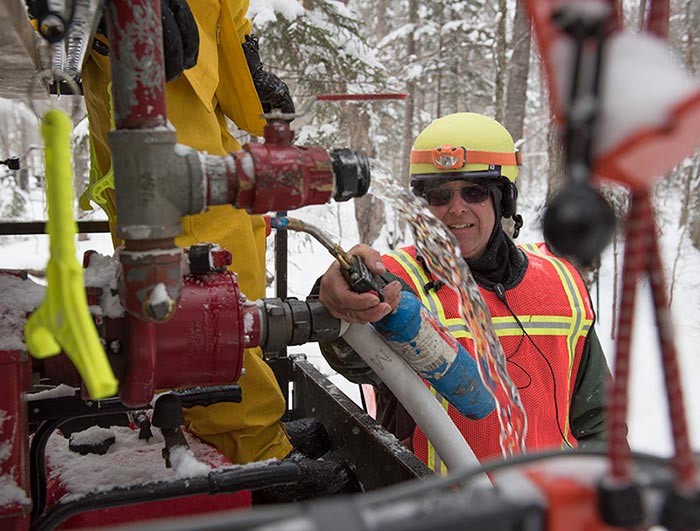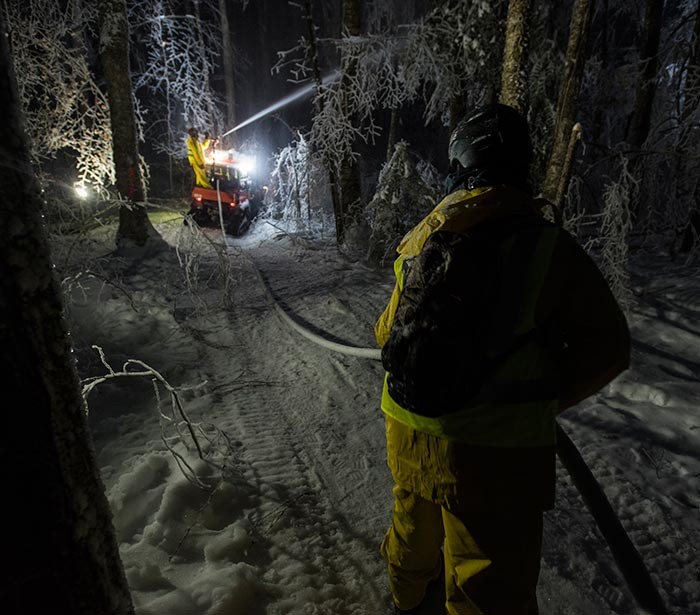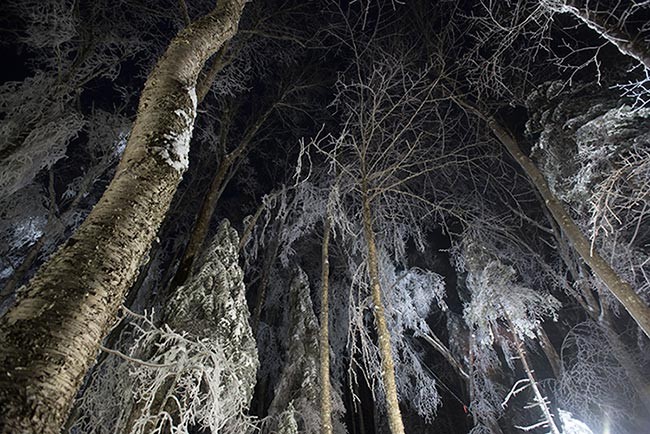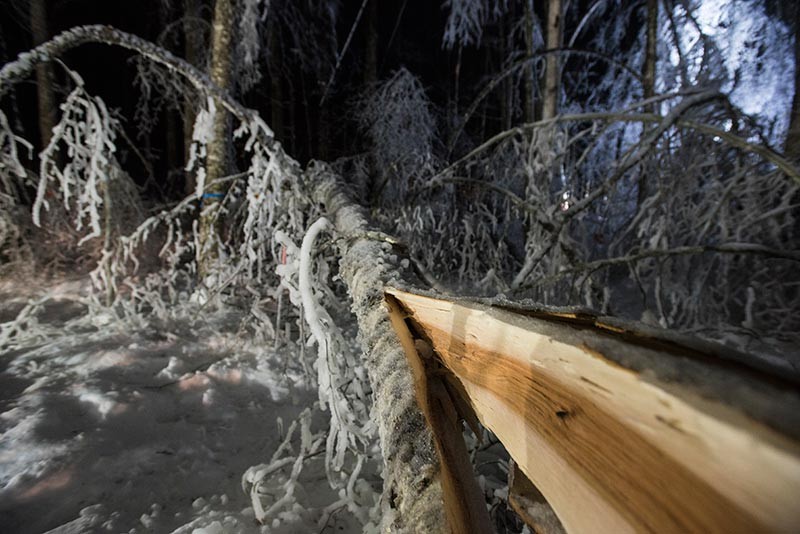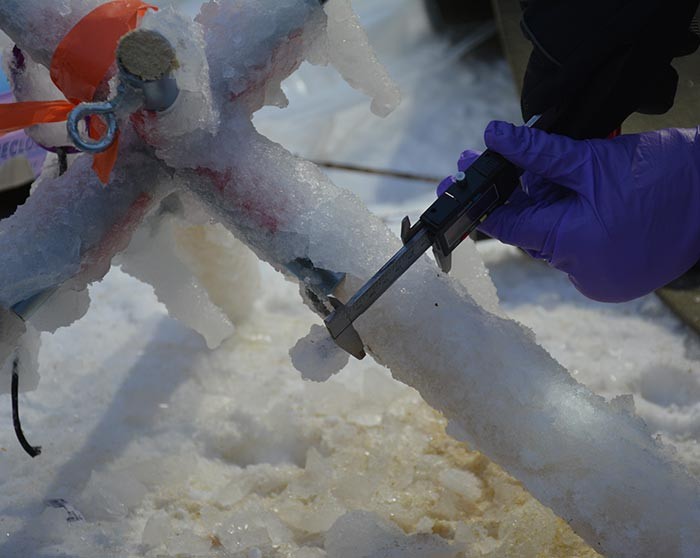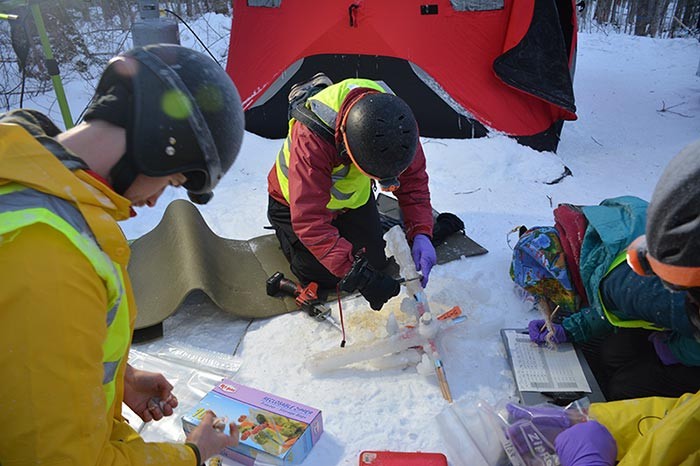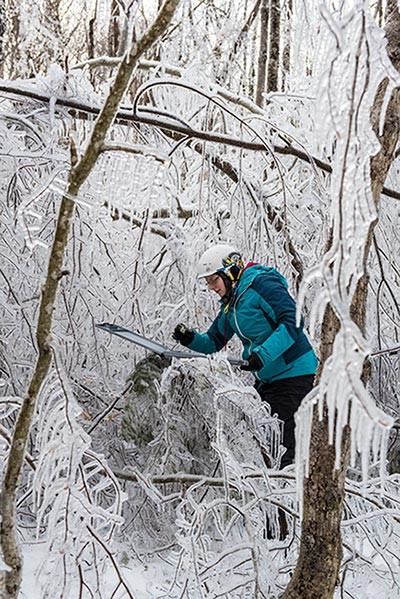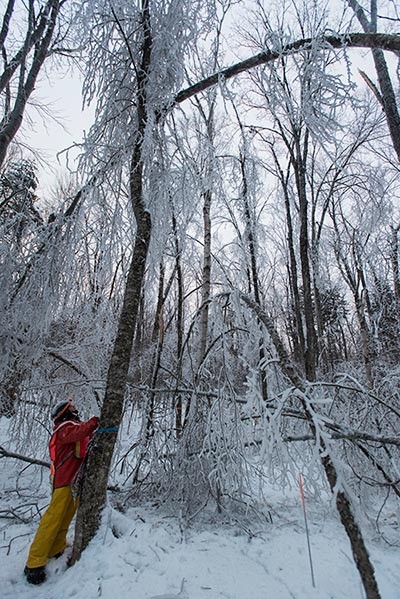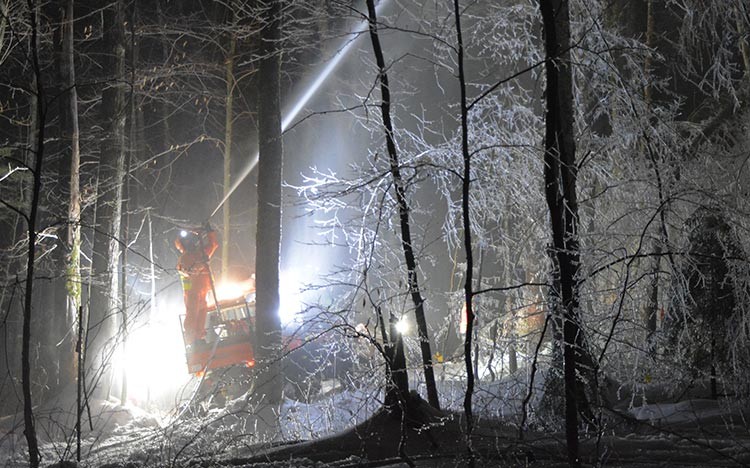
In the middle of a frozen New Hampshire night in January 2015, Geoff Schwaner was in Hubbard Brook Experimental Forest, standing on the back of a UTV and spraying water 100 feet up into the air with a fire hose. The water came back down in a fine, frozen mist, attaching itself to trees at the instant of contact and coating them thickly with ice. At first, the branches clinked together ethereally, then, as more and more ice accumulated, they bent, snapped, and loudly broke, crashing to the forest floor below. Some trees were wrenched from the frozen ground entirely, their root systems unable to support the added weight.
Schwaner is the field coordinator for an elaborate experiment designed to study the effects of ice storms, awesomely destructive yet strangely beautiful weather events with which most Northeasterners are all too familiar. The storms are caused by clouds of damp, warmer air moving over a ground layer of frozen air: as rain droplets fall from the warmer layer into the colder one, they supercool – that is, they dip below their freezing point without crystallizing – but do not freeze until they make contact with a solid object, like a tree branch. Once that freezing process begins, however, new water molecules bond rapidly with the growing encasements of ice, and entire sections of forest can be thickly and dangerously glazed in not much time at all.
In North America, ice storms typically wreak havoc in a belt stretching from Texas to southern New England, but climate-change science suggests that as the planet warms, the particular atmospheric conditions necessary for the deadly storms will become more common across a broader and more northerly geographic range. What’s even more alarming is how little we still know about the ecological impact of ice events. “No long-term ecological study of ice storms has ever been conducted,” said Lindsey Rustad, one of the experiment’s investigators. “We know from the literature that they are very likely to become more frequent and more severe, and yet there is hardly any quantified record of their effects on the edge of a northern hardwood forest.”
Even relatively mild ice storms can have a surprising impact.
Whenever the ice fells trees or breaks off limbs, it initiates a cascade of ecological effects: tree growth can often be stunted by the damage; all the decaying wood lying on the ground alters the amount of carbon and other nutrients in the soil; even the amount of light that reaches the ground is altered by the loss of canopy branches. That in turn affects the soil’s temperature, moisture, and even its microbial community.
That would be disconcerting enough, but in the case of frequent or severe storms – the very circumstances that are predicted for this region in the near future – the impact can be even more dramatic: a forest subjected to extreme or repeated ice storms can experience deep and long-lasting shifts in its ecosystem. “Forests in that situation may begin to favor tree species with stronger wood, more vertical branching patterns, or the ability to respond rapidly to dramatic changes in the availability of light and nutrients,” Rustad suggested. “Or to favor softwoods over hardwoods, because they can bend and shed ice more easily. This is all very important, because so many consequences for wildlife, hydrology, and forest nutrient cycling can hinge on changes in the structure, function, and species composition of the trees in a forest, and severe ice storms can heavily influence all of that.”
Naturally occurring ice storms are difficult to forecast and impossible to control, so in the interest of creating ideal experimental conditions, the researchers couldn’t simply wait for an ice storm and hope they could monitor it; they had to find a way to create one themselves.
Rustad says the germ of the idea for the experiment came to her after a harrowing drive through western Massachusetts in the winter of 2009, when that region was struck by an unusually savage ice storm. After she made it back safely to New Hampshire, she discussed the storm with forest ecologist John Campbell – now her fellow principal investigator for the study – and both scientists were stunned to discover such a dearth of existing knowledge about the impact of such storms.
A trial experiment in 2011, conducted at Hubbard Brook under Rustad’s and Campbell’s direction, proved that a fire hose could, if artfully wielded, artificially recreate the effects of an ice storm with surprising fidelity. This success emboldened the researchers to seek funding for a more far-reaching experiment, and in 2012, a grant from the National Science Foundation was awarded to seven research institutions (Syracuse University, the U.S. Forest Service, Texas Tech University, Cornell University, the Cary Institute of Ecosystem Studies, the University of Southern Maine, and the Hubbard Brook Research Foundation). They would collaborate on a new, comprehensive study looking into the myriad short- and long-term effects the storms can have.
The experiment is being conducted at Hubbard Brook Experimental Forest, a 7,000-acre outdoor laboratory at the edge of the White Mountains that has been the site of groundbreaking research in forest ecology since its establishment in 1955.
Researchers chose 10 basketball-court-sized plots in a section of forest selected in part for its access to roads (for the equipment) and proximity to Hubbard Brook (a flowing water source to feed the pump), but primarily because it is representative of a typical northern hardwood forest. “We wanted a nice mixture of American beech, sugar and red maple, and yellow and paper birch,” Rustad told me. “We definitely wanted hardwoods – we didn’t care too much about spruce or fir – and we also wanted to make sure they were a good representative age: the forest in each of these plots is about a hundred years old, which is about standard for this part of the country.”
Over the course of four freezing nights in January and February, eight of the ten plots were iced, each by a team of about 20 dedicated researchers and volunteers: two plots received a quarter-inch of ice, four received a half-inch, and one unlucky plot was coated in three-quarters of an inch of ice.
Almost immediately after the plots were iced, researchers began assessing the damage and comparing it with all the pretest ecological data they’d spent the summer and fall meticulously collecting: they had spent months measuring trees and shrubs, monitoring bird and insect populations, and getting to know the chemical composition of each section backwards and forwards. “We knew every single twig in those plots,” Rustad said. The experiment will investigate longer term effects as well: for decades into the future, scientists will return to these plots to monitor changes in everything from wildlife activity to soil composition to nitrogen cycling.
“An experiment like this could only have happened here,” said Ian Halm, a researcher and site manager at Hubbard Brook. The other researchers all gratefully credited Halm with conceiving of the ingenious plan to attach the fire hoses to UTVs instead of having researchers aim a giant hose by hand – desperately holding on as it wildly discharged near-freezing water at 250 PSI – as they had in the 2011 trial. “Hubbard Brook has the perfect combination of equipment, expertise, and geographic location for an experiment like this one. It required a lot of creativity and logistical planning, but it really drew on a lot of our greatest strengths, and I think we’ll get some interesting results.”
While the group of scientists is proud of the experiment’s unconventional execution and excited about the reams of data it will yield in the decades to come, by all accounts, the research conditions were absurdly unpleasant. All but a few of the icings took place at night, when the low air temperature and lack of sunlight would allow the ice to form quickest. In addition to the cold and the not-insignificant challenge of having to navigate a calamitous scene of falling trees in the dark, they also had to contend with the thousands of gallons of water being sprayed into the freezing air.
“We were bundled up: we all had winter gear on, and then, on top of that we had thick, rubber rainsuits,” Schwaner recalled, “but water even gets through that – I’d take my stuff off and I’d have ice all around my collar, going down my arms, just coating my torso. When I sprayed the first day, I had about 10 to 15 pounds of ice on me, and it was actually starting to rip up this industrial lobsterman suit I had on: whenever I bent my arms all the ice would tear at the laminate.”
“The worst thing,” he continued with something approaching bemusement, “was around your eyes, because if you tried wearing the ski goggles, they’d get iced up immediately, just totally encased, and there would just be no way you could see anything at all.”
I visited two of the plots the morning after they had been iced.
They were easy to spot in the leafless winter forest: giant and surreally well-defined cubes of white amid the gray woods. Rustad walked me through the icy plots, noting spots of exceptional destruction and noting proudly how well they’d managed to deliver, for instance, exactly a half-inch of ice to the half inch plots and exactly a quarter-inch to the quarter-inch plots.
It was interesting to look around and think of the chaos that had occurred just hours before: trees cracking and falling, a roaring water pump, a gushing fire hose, and 20 cold and wet scientists racing around trying to ensure that everything was going as smoothly as possible. It contrasted sharply with the eerie, frozen silence of the scene that remained the next morning.
We paused for a moment in the plot that had been entombed in three-quarters of an inch of ice, where many of the trees had been ripped to icy shreds by all the weight. “There’s something about these storms that is so sublime,” Rustad noted thoughtfully. “There was a point during each one of these icings when we could all feel the conditions suddenly tip from beautiful to dangerous. In one moment we were marveling at how strange and magical it all looked, but in the next, the whole canopy was suddenly coming down, we all had to run away from the plot, and I have to tell you, it was truly scary. It was like at any given moment you didn’t know what was going to happen, and you feared it could be anything.”


